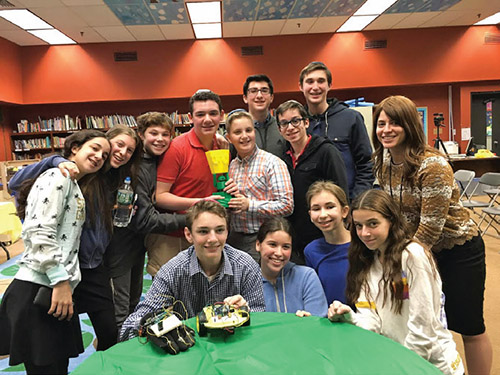


Paramus—It’s one thing to sit in class and learn about computers and technology. But Ben Porat Yosef’s Director of Technology Moshe Azizollahoff decided to give his students a chance to take these lessons and find real-life applications. As the scientific process benefits from the ability to share ideas with colleagues and see how others think and process information, Azizollahoff invited two other schools—Yavneh and Moriah—to join them in a friendly robotics competition.
“I wanted my class to see what other students are doing in their own schools and unify the schools through the competition,” explained Azizollahoff. “There is so much they can learn from each other, and so much they can apply from what they studied, things they didn’t even realize they knew how to do.”
Azizollahoff brought in judges from the high school level to participate in the competition. Rabbi Tzvi Pittinsky, the director of educational technology at The Frisch School, and Mrs. Orly Nadler, director of educational technology and co-director of STEAM at Ma’ayanot, judged and provided feedback and inspiration to the students. Additionally, Azizollahoff had Mr. Steve Paley attend the robotics competition. Paley, currently an educator at Frisch, but with a background in robotics innovation and technology, brought his real-life thought process to the event. “Having a visionary from the robotics field really added a unique element,” added Rabbi Pittinsky.
All the projects merged everyday materials with technology to not only make life more convenient for people, but in some cases to potentially improve quality of life.
Sixth and seventh graders at Yavneh Academy used coding and colored tiles to explain their robotic innovation. Their idea was to use color-coded tiles that communicate with a robot in order to instruct the robot on a certain path. Some of this technology can be used to help deliver mail to office cubicles, but the implications of this type of technology can extend further. This robot can be used to assist people in busy areas—such as an airport—where someone who has a visual impairment or other difficulties navigating can use the robot as it follows the pre-programmed route by using colored tiles. “The technology is already there,” the students explained. “We want to use it to help a larger group of people.”
Moriah eighth graders designed a glove that connects to a remote-controlled car. While at first this may just seem like a cool gadget, the students explained that this is a glove for people who have partial hand or finger amputations, or limited mobility in a hand. “Most remote-controlled activities are for two hands,” they explained in their presentation. This glove can be programmed and reprogrammed to control other devices and help in many different aspects of day-to-day functions.
Ben Porat Yosef sixth and seventh graders designed a robot to “help with lazy mornings.” They 3D printed materials and made this robot look like Pixar’s WALL-E robot, but it had speakers and a satellite connection to tell the user weather, play music and even hand over the toothbrush and toothpaste. “This is a perfect example of how technology integrates with the arts,” explained Nadler. “It has an artistic value, a playful feel and functionality.”
The judges and the students were all impressed by the creative thinking and the processes behind it. The students were encouraged to talk about not just the successes, but the failures and roadblocks they encountered and how they used those to improve their project. But since it was a competition, a winner still had to be chosen.
Who needs to order standard gold trophies when the school has its own 3D printer? Azizollahoff sat down and printed the trophy. “What better way to honor a technology innovator than with a trophy from cutting-edge materials?” he figured. The Robo Cup, as it was named, was awarded to Moriah’s team for their first-place idea and presentation.
“Wearable technology for recreational purposes has already been taking off as a cool trend,” said Rabbi Pittinsky, referring to devices like FitBits. “Wearable technology for assistive uses is really where this field is growing, and these students are thinking ahead.”
Now the judges, schools and even students are thinking ahead to next year. Students came up to the judges and their teachers asking questions and talking about “next year,” and their “next invention.” “We do these competitions because we always want students to be thinking. Reworking a prototype, looking for improvements,” said Rabbi Pittinsky. Nadler was also excited to see students exposed to these ideas at an early age. “When students were taught plain code, we found that they lost interest easily because it was too dry. Using the same code and making it do something has been an incredible development in technology education,” she explained.
“It’s about growing every year,” Nadler explained further. When she addressed the students she told them, “It’s great that you got exposure to this already and learned how to implement your ideas. When you learn that you can make your ideas better and add functionality, the growth is endless.” Nadler quoted inventor Nikola Tesla in her introductory remarks, inspiring the students to continue their thinking process: “I do not think there is any thrill that can go through the human heart like that felt by the inventor as he sees some creation of the brain unfolding to success.”
By Jenny Gans










